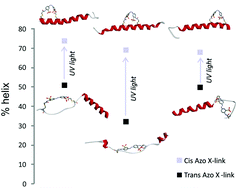The effect of azobenzene cross-linker position on the degree of helical peptide photo-control
Abstract
Photo-switchable α-helical

* Corresponding authors
a Department of Medicinal Chemistry, Faculty of Pharmacy, Assiut University, Assiut, Egypt
b
Department of Chemistry, University of Toronto, 80 St. George St., Toronto, ON, Canada
E-mail:
awoolley@chem.utoronto.ca
Fax: +1 (416) 978-8775
Tel: +1 (416) 978-0675
Photo-switchable α-helical

 Please wait while we load your content...
Something went wrong. Try again?
Please wait while we load your content...
Something went wrong. Try again?
A. M. Ali and G. A. Woolley, Org. Biomol. Chem., 2013, 11, 5325 DOI: 10.1039/C3OB40684A
To request permission to reproduce material from this article, please go to the Copyright Clearance Center request page.
If you are an author contributing to an RSC publication, you do not need to request permission provided correct acknowledgement is given.
If you are the author of this article, you do not need to request permission to reproduce figures and diagrams provided correct acknowledgement is given. If you want to reproduce the whole article in a third-party publication (excluding your thesis/dissertation for which permission is not required) please go to the Copyright Clearance Center request page.
Read more about how to correctly acknowledge RSC content.
 Fetching data from CrossRef.
Fetching data from CrossRef.
This may take some time to load.
Loading related content
